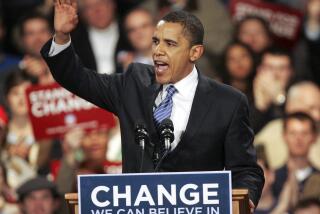3 Elections Get Vote as Most Interesting
- Share via
Question: Which political campaign can collectors of political memorabilia look to as being the landmark campaign as far as producing large amounts of collectible material? I think this is important in judging the value of some of the items in my collection--that is, the campaign that served to attract public interest in political souvenirs.--M.T.
Answer: Collector Robert Fratkin, former president of the American Political Items Collectors, points to three presidential elections as landmark events for political souvenir collectors: the Harrison-Van Buren campaign of 1840, and the McKinley-Bryan contests of 1896 and 1900.
Writing in the Encyclopedia of Collectibles (Time-Life Books), Fratkin says:
“William Henry Harrison’s campaign, won partly by his affectations of humble frontier origin, was the first to produce a large number of souvenirs, including Log Cabin almanacs, Old Cabin whiskey and tokens--small metal disks stamped with the candidate’s image.
“There were so many tokens, in fact, that they are as common as souvenirs from later elections.
“The McKinley-Bryan campaigns 50 years later, historically significant for the emotional debates on the gold standard for currency, are important because they produced the most popular collectible: the pin-back button.”
The earliest pin-backs, all highly collectible, were printed on paper, backed by metal and covered with clear celluloid--”hence the name celluloids for pin-backs of all kinds, even though other plastics later came into use,” Fratkin wrote.
As this election year heats up, undoubtedly collector interest in political collectibles will do likewise. Therefore, we’ll be writing more frequently about political items in the coming months.
One thought to keep in mind in connection with this highly popular collectible field: It’s been flooded with fakes, particularly counterfeit buttons. These can be particularly difficult to spot. When in doubt, collectors should consult with experts or seek some of the many books and publications on the subject.
One way to recognize fakes, experts such as Fratkin note, is to analyze the material used to produce them.
For example, he writes, a celluloid button with a backing of white metal, instead of unpainted tin, in all probability is a fake produced in recent years from the same metal used to produce Venetian blinds.
Recent reproductions of political items for product promotions--items never used in political campaigns--also fall into this “buyer beware” category.
Mailbag
A post-Valentine’s Day letter brought information that antique valentines and collectible perfume bottles are on display through the end of February at the Torrance Historical Society Museum, 1345 Post Ave., Torrance. For information, call (213) 328-5392.
More to Read
Get the L.A. Times Politics newsletter
Deeply reported insights into legislation, politics and policy from Sacramento, Washington and beyond. In your inbox twice per week.
You may occasionally receive promotional content from the Los Angeles Times.









